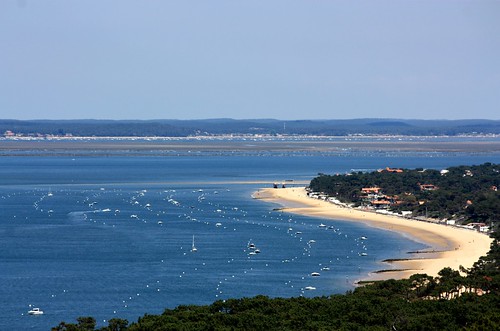La Dune du Pyla is just awesome. When you visit the largest sand dune in Europe, in the middle Atlantic coast of France, and with these few data in mind, it is impossible not to marvel at this training that is most like a ridge of a dune sand.

Photography by Danilo Paissan
Geographical Location:
With a summit of 104 meters above sea level, the Dune du Pilat is known as the Queen of the dunes by imposing control over the coast. Located on the picturesque Bay of Arcachon, washed by the ocean and many rivers that cross Aquitaine to die in this extraordinary landscape of sand banks of 1,500 hectares. From its summit can be seen as an army of sticks, called «pignots», reveal the status of oyster culture, very numerous in the area.
Before arriving at the Dune du Pyla, we surprised to see on the map a vast expanse of green that announces a lush vegetation that is lost in the skyline. This is the Landes, the biggest forest in Europe by maritime pines, some 600,000 hectares in contrast to the golden sand dunes.
Past and future:
In winter, when the dune is less crowded and trampled on its slopes can be darker lines, which reveal the formation of the paleosols, which tell their story. At the entrance to the area, a wall chart reveals interesting history of the dune and its future. The training moves at a speed of four meters per year and it has engulfed a hotel and nearby parts of camping. Experts estimate that in a century, the dune will reach the access road and a daughter, smaller but very active, it moves even faster.
Surfer water and sand:
To climb the dune, a few steps pave the way artificial. The more intrepid can ascend the slope directly, or what is more fun, go down the hillside, but we recommend it diagonally, because it can reach dangerous speeds in a fall. The slope has great untapped emotions that surfers from around the world flock to the area, especially at Hossegor and Capbreton, where they go to hunt the giant waves of the Atlantic, but it is common to see groups of young people to pause and surfing on the slopes of Pyla.

Photography by laurent.breillat
Historic crossroads:
The beauty, abundant water and vegetation of the Landes justify its colonization since prehistoric times. The area, now a French department, has been a direct witness to military conflicts such as the Hundred Years War and the religious conflicts that rocked the region in the nineteenth century. In the area across three of the four pilgrimage routes that pass through France to Santiago de Compostela, making it a busy area with a rich culture and attractions like the nearby vineyards of Pomerol, they deserve a separate post.

Photography by Commutr
Come to the Dune du Pyla and discover the other side of France!
Leave a Reply
You must be logged in to post a comment.
Recent Comments